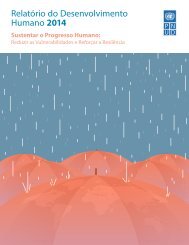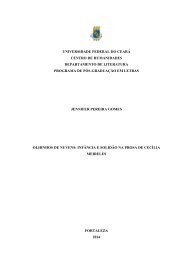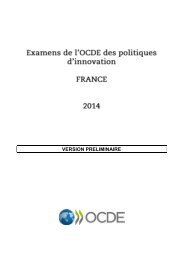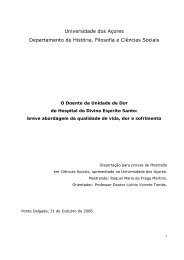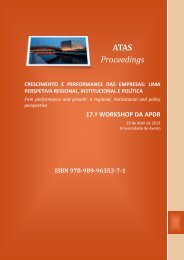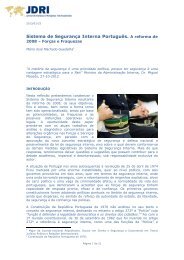- Page 1 and 2: Listagem dos organismos terrestres
- Page 3 and 4: Listagem dos organismos terrestres
- Page 5 and 6: sUmÁrio (sUmmarY) Prefácio Prefac
- Page 7 and 8: PrefÁCio Nos últimos anos, graça
- Page 9 and 10: CaPÍtULo 1 ChaPter 1 desCriçÃo d
- Page 11 and 12: 5. Compared to the other nearest Ma
- Page 13 and 14: (Departamento de Oceanografia e Pes
- Page 15 and 16: in the Azores. A total of 270 under
- Page 17 and 18: very effective in what concerns mar
- Page 19 and 20: the Canary Islands (Izquierdo et al
- Page 21 and 22: Quadro 3. (Table 3) (cont.) Overall
- Page 23: Quadro 5. Diversidade de taxa endé
- Page 27 and 28: are mainly limited to those sites u
- Page 29 and 30: It would be most important and inte
- Page 31 and 32: support of many organizations and i
- Page 33: Homem, N. & Gabriel, R. (2008) Bri
- Page 37 and 38: CaPÍtULo 2 ChaPter 2 Lista dos fUn
- Page 39 and 40: end - species endemic to azores, i.
- Page 41 and 42: d g esPéCies (sPeCies) az Cor fLo
- Page 43 and 44: d g esPéCies (sPeCies) az Cor fLo
- Page 45 and 46: d g esPéCies (sPeCies) az Cor fLo
- Page 47 and 48: d g esPéCies (sPeCies) az Cor fLo
- Page 49 and 50: d g esPéCies (sPeCies) az Cor fLo
- Page 51 and 52: d g esPéCies (sPeCies) az Cor fLo
- Page 53 and 54: d g esPéCies (sPeCies) az Cor fLo
- Page 55 and 56: d g esPéCies (sPeCies) az Cor fLo
- Page 57 and 58: d g esPéCies (sPeCies) az Cor fLo
- Page 59 and 60: CaPÍtULo 3 ChaPter 3 Lista dos LÍ
- Page 61 and 62: Bibliografia seleccionada (selected
- Page 63 and 64: d g esPéCies (sPeCies) az Cor fLo
- Page 65 and 66: d g esPéCies (sPeCies) az Cor fLo
- Page 67 and 68: d g esPéCies (sPeCies) az Cor fLo
- Page 69 and 70: d g esPéCies (sPeCies) az Cor fLo
- Page 71 and 72: d g esPéCies (sPeCies) az Cor fLo
- Page 73 and 74: d g esPéCies (sPeCies) az Cor fLo
- Page 75 and 76:
d g esPéCies (sPeCies) az Cor fLo
- Page 77 and 78:
d g esPéCies (sPeCies) az Cor fLo
- Page 79:
d g esPéCies (sPeCies) az Cor fLo
- Page 82 and 83:
notas explicativas As diatomáceas
- Page 84 and 85:
Bibliografia (references) Azevedo,
- Page 86 and 87:
d g esPéCies (sPeCies) az Cor fLo
- Page 88 and 89:
d g esPéCies (sPeCies) az Cor fLo
- Page 90 and 91:
d g esPéCies (sPeCies) az Cor fLo
- Page 92 and 93:
d g esPéCies (sPeCies) az Cor fLo
- Page 94 and 95:
d g esPéCies (sPeCies) az Cor fLo
- Page 96 and 97:
d g esPéCies (sPeCies) az Cor fLo
- Page 99 and 100:
CaPÍtULo 5 ChaPter 5 LISTA DE BRI
- Page 101 and 102:
or with unconfirmed occurrences in
- Page 103 and 104:
d g esPéCies (sPeCies) az Cor fLo
- Page 105 and 106:
d g esPéCies (sPeCies) az Cor fLo
- Page 107 and 108:
d g esPéCies (sPeCies) az Cor fLo
- Page 109 and 110:
d g esPéCies (sPeCies) az Cor fLo
- Page 111 and 112:
d g esPéCies (sPeCies) az Cor fLo
- Page 113 and 114:
d g esPéCies (sPeCies) az Cor fLo
- Page 115:
d g esPéCies (sPeCies) az Cor fLo
- Page 118 and 119:
notas explicativas A presente lista
- Page 120 and 121:
mente escapadas de cultura). Embora
- Page 122 and 123:
d g esPéCies (sPeCies) az Cor fLo
- Page 124 and 125:
d g esPéCies (sPeCies) az Cor fLo
- Page 126 and 127:
d g esPéCies (sPeCies) az Cor fLo
- Page 128 and 129:
d g esPéCies (sPeCies) az Cor fLo
- Page 130 and 131:
d g esPéCies (sPeCies) az Cor fLo
- Page 132 and 133:
d g esPéCies (sPeCies) az Cor fLo
- Page 134 and 135:
d g esPéCies (sPeCies) az Cor fLo
- Page 136 and 137:
d g esPéCies (sPeCies) az Cor fLo
- Page 138 and 139:
d g esPéCies (sPeCies) az Cor fLo
- Page 140 and 141:
d g esPéCies (sPeCies) az Cor fLo
- Page 142 and 143:
d g esPéCies (sPeCies) az Cor fLo
- Page 144 and 145:
d g esPéCies (sPeCies) az Cor fLo
- Page 146 and 147:
d g esPéCies (sPeCies) az Cor fLo
- Page 148 and 149:
notas explicativas O filo Platyhelm
- Page 150 and 151:
d g esPéCies (sPeCies) az Cor fLo
- Page 153 and 154:
CaPÍtULo 8 ChaPter 8 Lista dos ane
- Page 155:
d g esPéCies (sPeCies) az Cor fLo
- Page 158 and 159:
notas explicativas Os nemátodes s
- Page 160 and 161:
d g esPéCies (sPeCies) az Cor fLo
- Page 162 and 163:
d g esPéCies (sPeCies) az Cor fLo
- Page 165 and 166:
CaPÍtULo 10 ChaPter 10 Lista dos m
- Page 167:
Bibliografia (references) Backhuys,
- Page 170 and 171:
Fruto do isolamento, da situação
- Page 172 and 173:
Uma análise detalhada à malacofau
- Page 174 and 175:
Bibliografia (references) Arechaval
- Page 176 and 177:
d g esPéCies (sPeCies) az Cor fLo
- Page 179 and 180:
CaPÍtULo 11 ChaPter 11 Lista dos a
- Page 181 and 182:
2 Smithsonian Institution, National
- Page 183 and 184:
icardo Palma PHTHIRAPTERA Museum of
- Page 185 and 186:
Volker assing COLEOPTERA (Staphylin
- Page 187 and 188:
adrian C. Pont DIPTERA (Fanniidae,
- Page 189 and 190:
Xavier espadaler HYMENOPTERA (Formi
- Page 191 and 192:
For some groups we followed other s
- Page 193 and 194:
notas eCoLógiCas e taXonómiCas eC
- Page 195 and 196:
Quadro 1/ Table 1 hospedeiros (aves
- Page 197 and 198:
Bibliografia (references) Bezzi, M.
- Page 199 and 200:
d g esPéCies (sPeCies) az Cor fLo
- Page 201 and 202:
d g esPéCies (sPeCies) az Cor fLo
- Page 203 and 204:
d g esPéCies (sPeCies) az Cor fLo
- Page 205 and 206:
d g esPéCies (sPeCies) az Cor fLo
- Page 207 and 208:
d g esPéCies (sPeCies) az Cor fLo
- Page 209 and 210:
d g esPéCies (sPeCies) az Cor fLo
- Page 211 and 212:
d g esPéCies (sPeCies) az Cor fLo
- Page 213 and 214:
d g esPéCies (sPeCies) az Cor fLo
- Page 215 and 216:
d g esPéCies (sPeCies) az Cor fLo
- Page 217 and 218:
d g esPéCies (sPeCies) az Cor fLo
- Page 219 and 220:
d g esPéCies (sPeCies) az Cor fLo
- Page 221 and 222:
d g esPéCies (sPeCies) az Cor fLo
- Page 223 and 224:
d g esPéCies (sPeCies) az Cor fLo
- Page 225 and 226:
d g esPéCies (sPeCies) az Cor fLo
- Page 227 and 228:
d g esPéCies (sPeCies) az Cor fLo
- Page 229 and 230:
d g esPéCies (sPeCies) az Cor fLo
- Page 231 and 232:
d g esPéCies (sPeCies) az Cor fLo
- Page 233 and 234:
d g esPéCies (sPeCies) az Cor fLo
- Page 235 and 236:
d g esPéCies (sPeCies) az Cor fLo
- Page 237 and 238:
d g esPéCies (sPeCies) az Cor fLo
- Page 239 and 240:
d g esPéCies (sPeCies) az Cor fLo
- Page 241 and 242:
d g esPéCies (sPeCies) az Cor fLo
- Page 243 and 244:
d g esPéCies (sPeCies) az Cor fLo
- Page 245 and 246:
d g esPéCies (sPeCies) az Cor fLo
- Page 247 and 248:
CaPÍtULo 12 ChaPter 12 Lista dos V
- Page 249 and 250:
introduction As a result of the geo
- Page 251 and 252:
notas eCoLógiCas e taXonómiCas eC
- Page 253 and 254:
some Azorean islands, the Azorean b
- Page 255 and 256:
AVES Pedro rodrigues 1 , Joël Brie
- Page 257 and 258:
atricapilla gularis, the common sta
- Page 259 and 260:
d g esPéCies (sPeCies) az Cor fLo
- Page 261 and 262:
d g esPéCies (sPeCies) az Cor fLo
- Page 263 and 264:
d g esPéCies (sPeCies) az Cor fLo
- Page 265 and 266:
d g esPéCies (sPeCies) az Cor fLo
- Page 267 and 268:
d g esPéCies (sPeCies) az Cor fLo
- Page 269 and 270:
d g esPéCies (sPeCies) az Cor fLo
- Page 271:
d g esPéCies (sPeCies) az Cor fLo
- Page 275 and 276:
CaPÍtULo 13 ChaPter 13 Lista das m
- Page 277 and 278:
(O.F. Müller) Kuntze in the archip
- Page 279 and 280:
d g esPéCies (sPeCies) Ordem acroc
- Page 281 and 282:
d g esPéCies (sPeCies) PN Wrangeli
- Page 283 and 284:
d g esPéCies (sPeCies) rhodymeniac
- Page 285 and 286:
d g esPéCies (sPeCies) Ordem dicty
- Page 287 and 288:
CaPÍtULo 14 ChaPter 14 Lista de in
- Page 289 and 290:
maria ana dionísio & ana C. Costa
- Page 291 and 292:
explanatory notes Marine environmen
- Page 293 and 294:
The great number of marine inverteb
- Page 295 and 296:
Azores could result, at least parti
- Page 297 and 298:
d g esPéCies (sPeCies) Ordem Clath
- Page 299 and 300:
d g esPéCies (sPeCies) halichondri
- Page 301 and 302:
d g esPéCies (sPeCies) Ordem narco
- Page 303 and 304:
d g esPéCies (sPeCies) Ordem echiu
- Page 305 and 306:
d g esPéCies (sPeCies) endeidae n
- Page 307 and 308:
d g esPéCies (sPeCies) gammaridae
- Page 309 and 310:
d g esPéCies (sPeCies) Ordem decap
- Page 311 and 312:
d g esPéCies (sPeCies) Portunidae
- Page 313 and 314:
d g esPéCies (sPeCies) Conidae (co
- Page 315 and 316:
d g esPéCies (sPeCies) Velutinidae
- Page 317 and 318:
d g esPéCies (sPeCies) dendrodorid
- Page 319 and 320:
d g esPéCies (sPeCies) Pectinidae
- Page 321 and 322:
d g esPéCies (sPeCies) Candidae Sc
- Page 323 and 324:
d g esPéCies (sPeCies) Ordem Clype
- Page 325 and 326:
CaPÍtULo 15 ChaPter 15 Lista dos V
- Page 327 and 328:
explanatory notes The list of marin
- Page 329 and 330:
Bibliografia (references) Almada, V
- Page 331 and 332:
d g esPéCies (sPeCies) Ordem Chima
- Page 333 and 334:
d g esPéCies (sPeCies) Ordem albul
- Page 335 and 336:
d g esPéCies (sPeCies) Phosichthyi
- Page 337 and 338:
d g esPéCies (sPeCies) myctophidae
- Page 339 and 340:
d g esPéCies (sPeCies) Ceratiidae
- Page 341 and 342:
d g esPéCies (sPeCies) apogonidae
- Page 343 and 344:
d g esPéCies (sPeCies) scombridae
- Page 345:
d g esPéCies (sPeCies) Ordem Carni
- Page 348 and 349:
organismos terrestres (terrestriaL
- Page 350 and 351:
organismos terrestres (terrestriaL
- Page 353 and 354:
nome PP nome PP nome PP a Aaroniell
- Page 355 and 356:
nome PP nome PP nome PP Amphiboloth
- Page 357 and 358:
nome PP nome PP nome PP Arthonia st
- Page 359 and 360:
nome PP nome PP nome PP Blastobasis
- Page 361 and 362:
nome PP nome PP nome PP Caloplaca c
- Page 363 and 364:
nome PP nome PP nome PP Ceratodon s
- Page 365 and 366:
nome PP nome PP nome PP Cladonia ra
- Page 367 and 368:
nome PP nome PP nome PP Cryptotheci
- Page 369 and 370:
nome PP nome PP nome PP Diplazium e
- Page 371 and 372:
nome PP nome PP nome PP Eremocoris
- Page 373 and 374:
nome PP nome PP nome PP Folsomia ca
- Page 375 and 376:
nome PP nome PP nome PP Gustavia oc
- Page 377 and 378:
nome PP nome PP nome PP Huperzia se
- Page 379 and 380:
nome PP nome PP nome PP Jungermanni
- Page 381 and 382:
nome PP nome PP nome PP Leptoscyphy
- Page 383 and 384:
nome PP nome PP nome PP m Macaroeri
- Page 385 and 386:
nome PP nome PP nome PP Mimulus mos
- Page 387 and 388:
nome PP nome PP nome PP Nicoletiida
- Page 389 and 390:
nome PP nome PP nome PP Ostearius m
- Page 391 and 392:
nome PP nome PP nome PP Pertusaria
- Page 393 and 394:
nome PP nome PP nome PP Piranga rub
- Page 395 and 396:
nome PP nome PP nome PP Prionolobus
- Page 397 and 398:
nome PP nome PP nome PP Ramalina fr
- Page 399 and 400:
nome PP nome PP nome PP Salmoniform
- Page 401 and 402:
nome PP nome PP nome PP Skeletocuti
- Page 403 and 404:
nome PP nome PP nome PP Strophosoma
- Page 405 and 406:
nome PP nome PP nome PP Tortula vah
- Page 407 and 408:
nome PP nome PP nome PP Vaccinium p
- Page 409:
ÍndiCe taXonómiCo taXonomiC indeX
- Page 412 and 413:
nome PP nome PP nome PP Arthropoda
- Page 414 and 415:
nome PP nome PP nome PP Conferva re
- Page 416 and 417:
nome PP nome PP nome PP Gibbula del
- Page 418 and 419:
nome PP nome PP nome PP Maurolicus
- Page 420 and 421:
nome PP nome PP nome PP Poeciloscle
- Page 422 and 423:
nome PP nome PP nome PP Tedania anh
- Page 424 and 425:
9. Lista dos nemátodes (nematoda)
- Page 426 and 427:
diptera - agromyzidae 233 Milos Cer
- Page 428 and 429:
12. Lista dos vertebrados (Chordata
- Page 431:
Apoios





